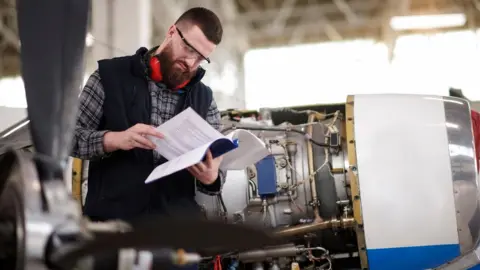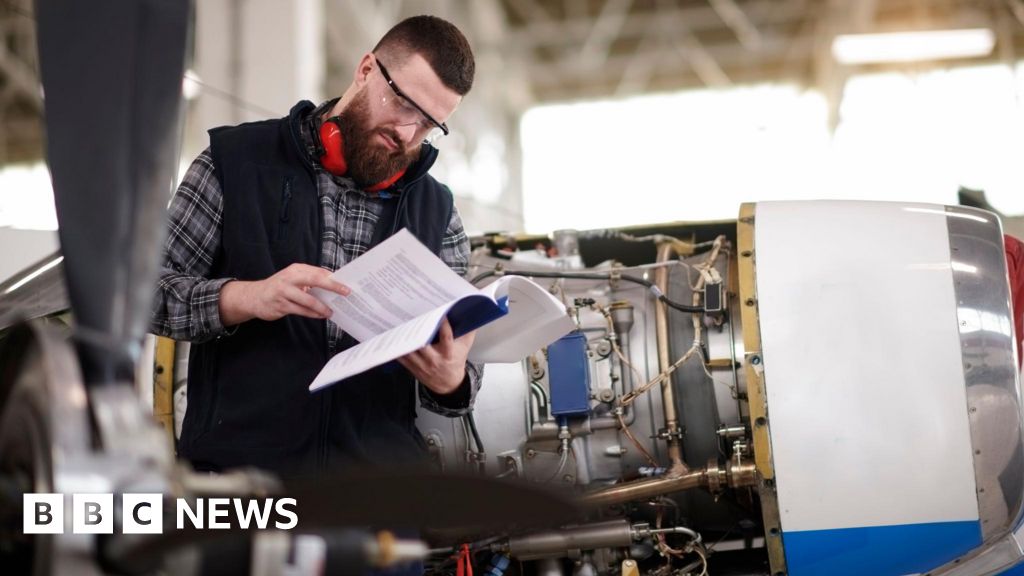 Getty Images
Getty ImagesDid you last look at the instruction manual when you purchased a new electronic device?
If your answer is a clear “no,” you are not alone.
Studies show that many of us don’t bother to read the instruction manual.
A British survey found that one in five of us skips the manual, while a US report said it was up to 50 %.
Caspar Herzberg, CEO of the British industrial software company Aveva, says he appreciates good manuals. “I’m a big fan of banal things!” But he understands that many people just throw them in the kitchen drawer and never read them.
While it’s not a problem for a consumer to skip the instruction manual, that’s not the case in industry, where engineers need to know exactly how the machines or computer systems they’re servicing work. This is especially true when a problem arises that they need to fix as quickly as possible.
To help these workers, Aveva has introduced an AI system that can read and learn manuals for them.
In its first incarnation, this AI memorized the technical manuals for the power grids and wind turbines managed by Aveva’s parent company, Schneider Electric.
In addition, it continuously monitors the machines via thousands of sensors.
The idea behind it is that AI can mimic the expertise of experienced engineers who have decades of practical know-how.
So how can AI help an energy worker trying to determine the cause of a disruption?
Simon Bennett, head of AI innovation at Aveva, says the AI can, for example, locate where there was a power outage and then delve into “a giant PDF manual.”
From this, the AI generates – via a computer screen – various ideas about what the problem might be.
In addition, a 3D image of the affected machinery, such as a turbine, can be created. Mr Bennett points out that engineers really appreciate such visual answers to their questions.
Aveva calls the system its “industrial AI assistant” and says it is designed to help solve a dilemma many companies face: an aging workforce that is retiring and taking its hard-earned knowledge with them.
So if someone is new to their job, Mr. Herzberg says, “the AI can guide them … and look up the manual for them.”
Or as Mr Bennett puts it: “By asking the AI system intelligent questions, we don’t have to wake up an old, retired engineer in the middle of the night and keep him on the phone for an hour.”
 Getty Images
Getty ImagesWhile Aveva has developed an AI system that can search instruction manuals, other technology companies have developed AIs that can create such product manuals in the first place.
California-based technology company Dozuki is one such company. Its AI-powered system CreatorPro can automatically generate an instruction manual by having an engineer create a video in which he or she explains and performs a process.
“The user uploads the video and a step-by-step guide is automatically created,” says Allen Yeung, Dozuki’s Vice President of Product. “The AI selects the text that accompanies each step and can automatically translate it into other languages.”
Currently, the AI creates video clips with accompanying text that other employees can read. Yeung said they are working on expanding the text-to-speech feature so that the AI can also dictate instructions through a computer speaker in the future.
However, the user manuals created by the AI still need to be approved by a human. “The user manuals are exported as a draft so that an engineer can review them,” says Yeung.
Yeung echoes Aveva’s comments, adding that Dozuki’s product aims to help companies deal with the fact that the manufacturing workforce is aging and more older workers are retiring.
 Getty Images
Getty ImagesSCG Chemicals, a Thai petrochemical company that will now use Aveva’s AI, says it is suffering from an aging workforce.
“Younger engineers turn to an expert when they have a problem, but many of our experienced employees are retiring in the next five years,” says department head Warit Krittaphol. “We cannot build a pipeline of experts. We have over 14 million documents in our system. AI will be able to quickly find the right information.”
Back in California, Scribe is another technology company that enables companies to automatically create AI user manuals. In Scribe’s case, the AI creates the manuals based on what a user has done on their computer.
“The technology works very simply: you click the record button and perform an action that you would normally have performed anyway, in the way you would normally do it,” says Scribe CEO Jennifer Swift.
“And when you’re done with your work, press Stop Recording. It will automatically generate a written step-by-step guide with screenshots, instructions, titles, etc. showing how to do the process.
“You as an individual have a lot of control over how you can edit it and add a lot of content, but the point is, you don’t have to. All the information someone needs to do the same process is automatically included in this step-by-step guide.”
Stuart Duff, a British industrial psychologist who describes his role as “working with people to understand how they behave in the workplace,” believes AI can be a useful shortcut for even the best engineer.
He points out that for engineers, leafing through a manual is no different than the rest of us.
“Most people are more familiar with detailed manuals and are therefore more adept and patient in looking up information,” he says.
“But personal preferences can also play a role in how engineers use manuals. Some engineers have a holistic thinking style and tend to rely on others’ information for certain information. So AI could provide a source of important details with easy and efficient access.”


